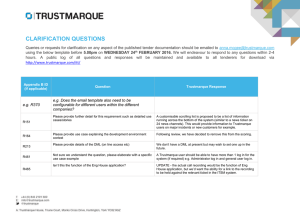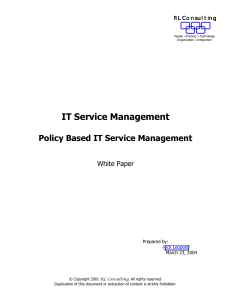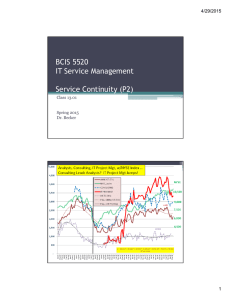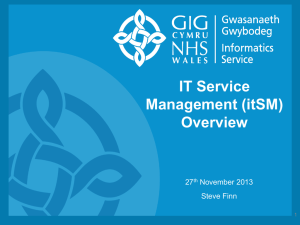ITSM Tutorial: Key Concepts, Frameworks, and Implementation
advertisement
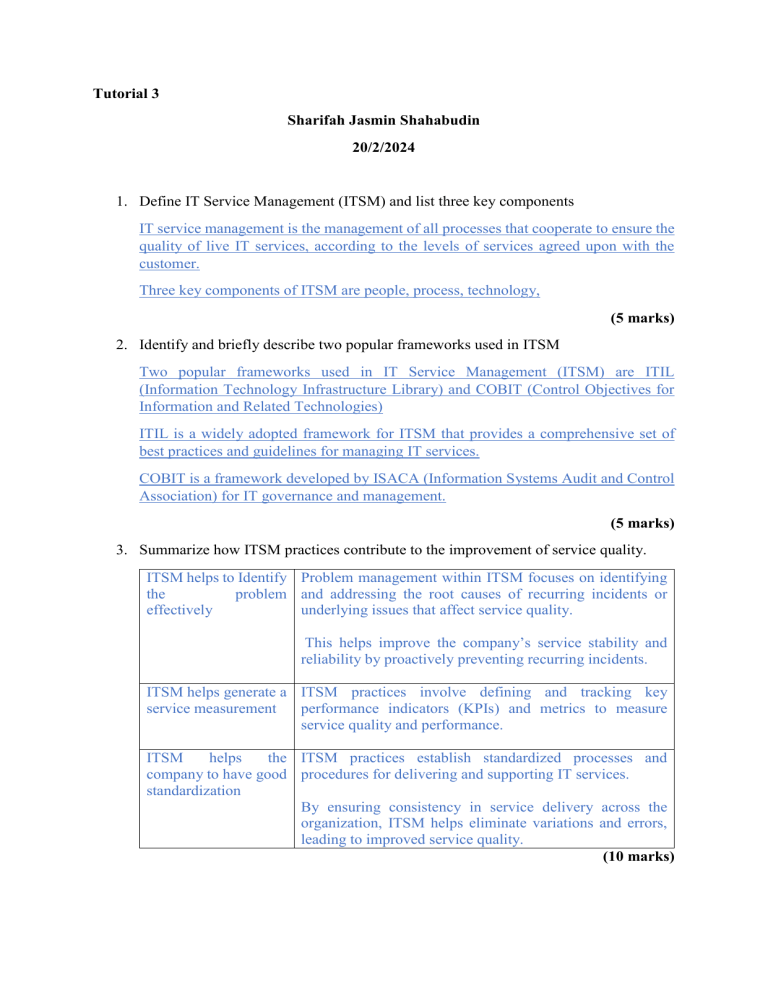
Tutorial 3 Sharifah Jasmin Shahabudin 20/2/2024 1. Define IT Service Management (ITSM) and list three key components IT service management is the management of all processes that cooperate to ensure the quality of live IT services, according to the levels of services agreed upon with the customer. Three key components of ITSM are people, process, technology, (5 marks) 2. Identify and briefly describe two popular frameworks used in ITSM Two popular frameworks used in IT Service Management (ITSM) are ITIL (Information Technology Infrastructure Library) and COBIT (Control Objectives for Information and Related Technologies) ITIL is a widely adopted framework for ITSM that provides a comprehensive set of best practices and guidelines for managing IT services. COBIT is a framework developed by ISACA (Information Systems Audit and Control Association) for IT governance and management. (5 marks) 3. Summarize how ITSM practices contribute to the improvement of service quality. ITSM helps to Identify Problem management within ITSM focuses on identifying the problem and addressing the root causes of recurring incidents or effectively underlying issues that affect service quality. This helps improve the company’s service stability and reliability by proactively preventing recurring incidents. ITSM helps generate a ITSM practices involve defining and tracking key service measurement performance indicators (KPIs) and metrics to measure service quality and performance. ITSM helps the ITSM practices establish standardized processes and company to have good procedures for delivering and supporting IT services. standardization By ensuring consistency in service delivery across the organization, ITSM helps eliminate variations and errors, leading to improved service quality. (10 marks) 4. Propose two strategies for effectively engaging stakeholders during the ITSM implementation. Strategy one: Stakeholder Workshops and Training Stakeholder workshops and training sessions are effective ways to engage stakeholders by providing them with the knowledge and skills necessary for successful ITSM implementation. By organizing workshops, organizations can address any concerns or misconceptions about ITSM. Example: The IT department organizes stakeholder workshops to educate employees about the benefits of ITSM implementation Strategy Two Continuous Feedback Mechanisms Continuous feedback mechanisms are essential for engaging stakeholders and ensuring their voices are heard throughout the ITSM implementation process. Regular feedback sessions also demonstrate the organization's commitment to transparency and collaboration Example: The IT department establishes feedback mechanisms such as suggestion boxes, online surveys, and regular feedback session. (10 marks) 5. Analyze the potential risks associated with insufficient investment in ITSM implementation. Loss of Competitive Advantage Organizations that underinvest in ITSM risk falling behind competitors, losing market share, and missing out on revenue opportunities. Increased Security Vulnerabilities and Without good incident management, and Data Breaches risk mitigation measures in place, organizations are more susceptible to breaches, malware infections, and unauthorized access to sensitive information. Decreased Service Quality and Customer Without proper ITSM implementation, Satisfaction organizations may struggle to effectively manage IT incidents. This can result in increased downtime, slower response times, and lower service quality, leading to dissatisfaction among customers, employees, and other stakeholders (10 marks) 6. Discuss real-world examples of organizations facing these risks due to poor ITSM practices. British Airways Data Breach (2018): In 2018, British Airways suffered a significant data breach affecting approximately 500,000 customers. The breach resulted in the theft of sensitive customer information, including names, addresses, payment card details, and travel booking details. It led to regulatory investigations, legal actions, and reputational damage for British Airways, highlighting the importance of robust ITSM practices for cybersecurity risk management. Amazon Web Services Outage (2017): In 2017, Amazon Web Services (AWS), a leading cloud computing provider, experienced a widespread service outage that affected thousands of websites and online services. The AWS outage impacted numerous organizations reliant on AWS infrastructure, leading to lost revenue, disrupted operations, and reputational damage. It highlighted the importance of robust ITSM practices for ensuring service availability, reliability, and resilience in cloud environments. Delta Air Lines System Outage (2016): In 2016, Delta Air Lines experienced a major system outage that resulted in thousands of flight cancellations and delays worldwide. This happened due to a power outage at Delta's data center triggered a chain reaction that caused disruptions to critical IT systems, including reservations, flight operations, and customer service. (10 marks) 7. Evaluate the success factors in a case study of an organization's ITSM implementation. Microsoft and Sustainability Environmental Microsoft has reduced its carbon footprint and minimized environmental impact. Through initiatives like AI for Earth and the Microsoft Sustainability Calculator, the company leverages ITSM practices to advance environmental causes, drive innovation, and promote responsible business practices across its global operations. Google and Education Accessibility By developing innovative educational tools like Google Classroom, G Suite for Education, and Chromebooks, Google empowers students and educators with digital resources and collaborative learning platforms. Through ITSM practices such as service desk support, continuous improvement, and user feedback mechanisms, Google ensures that its educational technologies are accessible. Amazon and Community Development Amazon, a leading e-commerce and technology company, has implemented ITSM practices to support community development initiatives and promote economic empowerment. Through programs like Amazon Web Services (AWS) Activate, which provides resources and support to startups and nonprofits, Amazon leverages its IT capabilities to foster innovation, entrepreneurship, and job creation in underserved communities. (10 marks)


